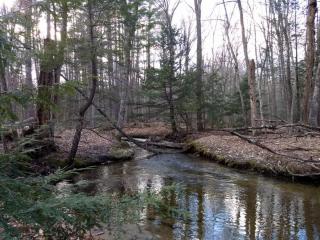Black Brook Habitat Restoration

By the Belknap County Conservation District (belknapccd.org)
There are a number of natural resource conservation projects planned in Sanbornton. The Belknap County Conservation District (BCCD) and Trout Unlimited are working with local landowners and the Sanbornton Conservation Commission on projects in the Black Brook watershed. During the summer of 2020, a stream assessment of Black Brook identified the need to improve aquatic habitat. With the permission of landowners, stream habitat restoration will be implemented in a one mile section Black Brook in late August or September this year. Black Brook is a 2.6 mile long stream system which flows into Lake Winnisquam. The stream restoration project will consist of adding instream large wood to Black Brook, mimicking natural processes. This work benefits native Eastern brook trout populations, and protects water quality by reducing sediment and excess flow of nutrients into Lake Winnisquam. This project is funded through grants from the NH Association of Conservation Districts, the National Fish and Wildlife Foundation and NH Moose Plate license fees.
Why add wood to streams?
Large wood in streams is an important component of the forest ecosystem, and serves a critical role in aquatic habitat. Placement of instream large wood changes water velocity to trap sediment, and creates cascades and riffles, which increases oxygen in the water. The alteration of flow and velocity aids to form deeper pools where fish can survive the warmer summer water temperatures and recharges ground water. By collecting leaves and twigs, wood structures can also provide cover and refuge. Leaves and twigs, both organic matter, feed insects and invertebrates, which are the main food source for Eastern brook trout. Large wood additions to streams truly benefit the overall aquatic ecosystem and conserve habitat and water quality.
Assessing Stream Crossings and Sediment Sources
During 2020, BCCD contracted with Trout Unlimited to assess stream crossings in the Black Brook watershed. This assessment was submitted to the State Department of Environmental Services and flow projections were completed by State Geologic Survey staff. The assessment indicates that half of the eleven culverts in the Black Brook watershed need improvement or replacement to meet storm water projections. To provide information about erosion sources and recommendations to reduce sedimentation into Black Brook, Lang Engineering was hired by BCCD to develop a report and recommendations for actions needed to address these concerns. This report will be completed in 2021 and be presented to the Conservation Commission. BCCD will assist the Town of Sanbornton in identifying grants and technical assistance to address the concerns identified. The stream crossing assessment and engineering study are funded through a NH Moose plant grants obtained by BCCD.
To learn more about Eastern brook trout, their habitat needs and the strategic placement of wood in streams; the Black Brook stream crossing survey or engineering study, contact the Belknap County Conservation District or visit their website at www.belknapccd.org (watch for their website update in April).
The Belknap County Conservation District (BCCD) was established on February 14, 1946 by NH RSA to serve as a non-regulatory implementor of on-the-ground conservation measures and a resource for the leveraging of federal, state, and local funding to assist landowners and managers in maintaining Belknap County’s land,water, and related natural resources.

